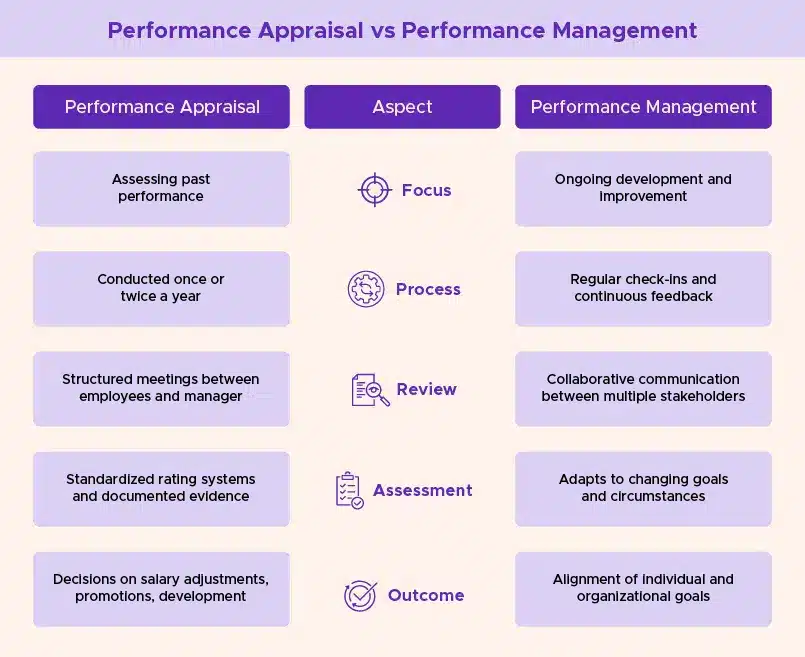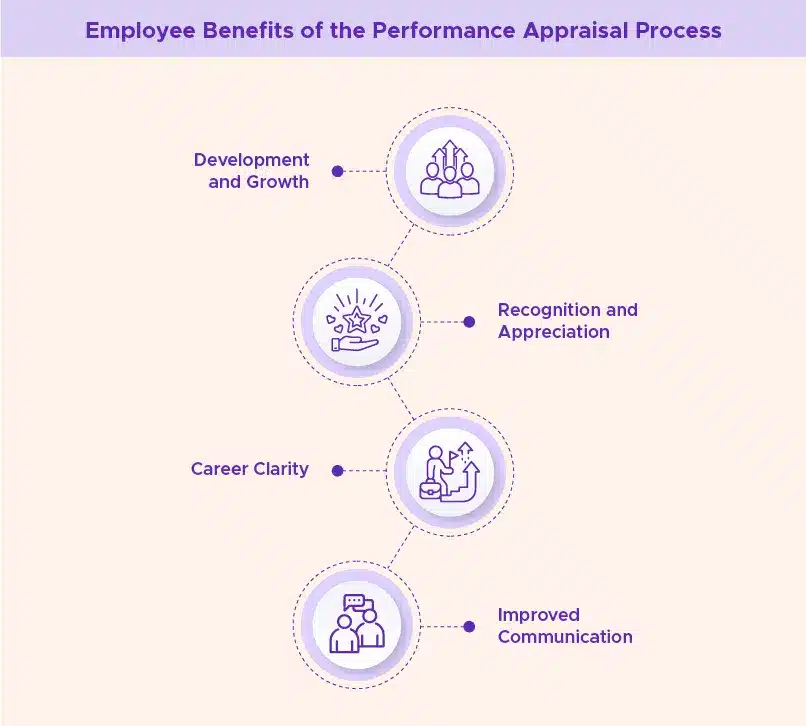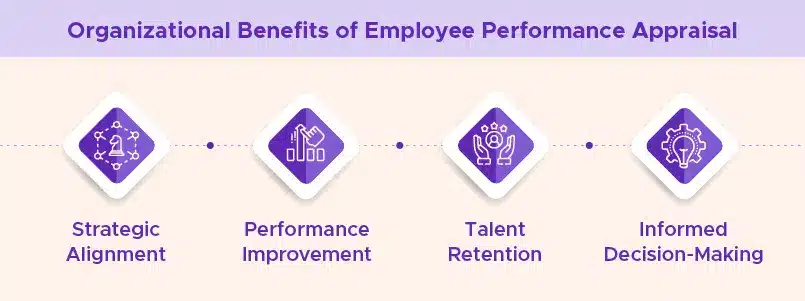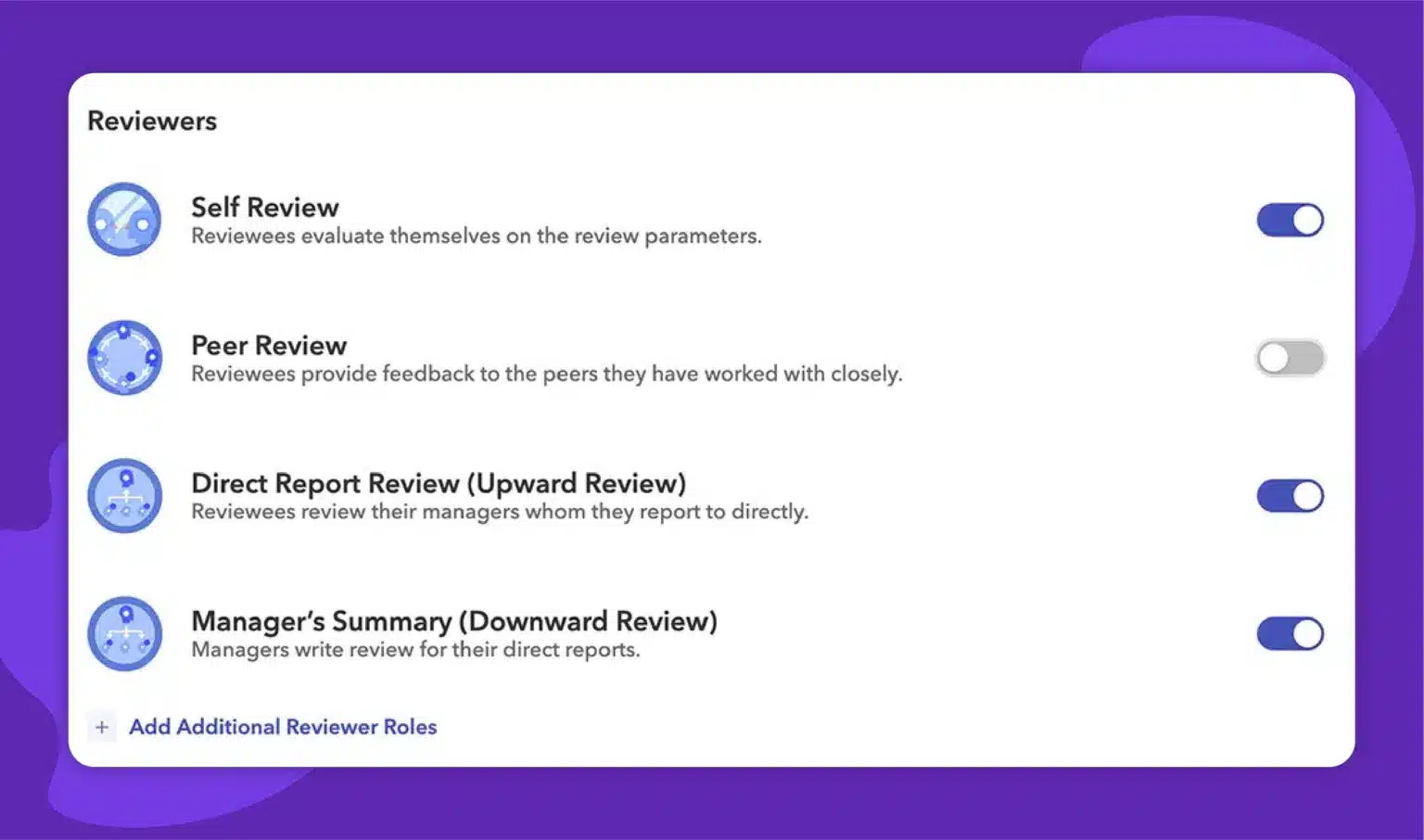Have you ever walked into a performance appraisal with a sinking feeling, bracing yourself for awkward silences, vague feedback, and struggling to identify areas for improvement? You’re not alone.
But what if performance appraisals could be more than just a box-checking exercise? Imagine a meeting where:
✅ Your hard work is recognized
✅ You get valuable insights to grow
✅ There’s genuine two-way communication
In this blog post, we show you how to use performance appraisals as a strategic tool for both employee development and organizational success.

What is a Performance Appraisal?
A performance appraisal is a structured evaluation process that reviews an employee’s performance, contributions, and growth over a specific period. It helps managers assess how well employees meet pre-defined goals and identify areas for improvement and development.
But it’s not just about evaluation it’s about:
- Recognizing achievements
- Identifying strengths & gaps
- Shaping career growth
- Facilitating meaningful feedback
Performance appraisals serve multiple purposes, including guiding decisions about promotions, compensation, training needs, and sometimes disciplinary actions.
Performance Appraisal vs Performance Management
While often used interchangeably, performance appraisal and performance management are distinct processes that serve different but complementary purposes within an organization.
Performance appraisal is a retrospective process focused on evaluating an employee’s performance over a specific period. It is typically conducted biannually or annually and provides a snapshot of past performance, which informs decisions about promotions, compensation, training needs, and sometimes disciplinary actions.
Key Characteristics of Performance Appraisal:
- Evaluation Focus: Centers on assessing past performance against predefined criteria and goals.
- Periodic Process: Usually conducted once or twice a year.
- Formal Review: Involves a structured performance review meeting between the employee and their manager.
- Objective Assessment: Uses a standardized performance ratings system and documented evidence to evaluate performance.
- Outcome-Oriented: Results in decisions about salary adjustments, promotions, and developmental needs.
Performance management, on the other hand, is a continuous, holistic process that aims to develop and enhance employee performance in alignment with organizational goals. It involves ongoing communication, coaching, and feedback throughout the year rather than a single annual review.
Key Characteristics of Performance Management Process:
- Development Focus: Emphasizes ongoing development and improvement.
- Continuous Process: Involves regular check-ins, feedback, and adjustments throughout the year.
- Collaborative Approach: Encourages active participation and communication between managers and employees.
- Dynamic and Flexible: Adapts to changing goals and circumstances, allowing for mid-course corrections.
- Goal Alignment: Ensures that individual objectives are aligned with organizational priorities.

| Aspect | Performance Appraisal (Looking Back) | Performance Management (Looking Forward) |
| Focus | Evaluates past performance | Continuous improvement & development |
| Timing | Conducted annually or biannually | Ongoing process with regular check-ins |
| Approach | Formal & structured review | Collaborative & flexible |
| Key Objective | Measures achievements & areas for improvement | Helps employees develop & align with company goals |
| Evaluation Criteria | Uses predefined goals & standardized ratings | Adjusts dynamically based on performance feedback |
| Outcome | Decisions on salary, promotions, & training | Enhances engagement, productivity, & career growth |
| Adaptability | Fixed process with set timelines | Flexible and evolves with business needs |
By integrating both performance appraisals and performance management, companies create a stronger, more effective strategy for employee growth and business success!
Forward-thinking organizations integrate both performance appraisal and performance management to create a comprehensive performance strategy. While performance appraisals provide the necessary evaluations and formal assessments, performance management ensures continuous improvement and alignment with organizational goals.
Together, they create a supportive environment where employees can thrive, develop their skills, and contribute meaningfully to the organization’s success. We talk all about how performance management is different from performance appraisals in our blog post. Give it a read!
Why Should You Conduct Performance Appraisals?
Gone are the days when performance appraisals were just another box to check off. Today, they’re a game-changer for building a high-performing, engaged workforce.
Here are some of the benefits they provide:
Employee Benefits of the Performance Appraisal Process

Development and Growth
Appraisals provide a valuable opportunity for employees to receive feedback on their performance, identify areas for improvement, and set goals for future development. This ongoing dialogue helps employees stay motivated and engaged in their work.
Recognition and Appreciation
Appraisals offer a platform to acknowledge and celebrate an employee’s achievements. Formal recognition can boost employee morale, improve job satisfaction, and motivate employees to continue exceeding expectations.
Career Clarity
Through regular discussions, employees gain a clearer understanding of their strengths, weaknesses, and career aspirations. This clarity allows them to make informed decisions about their professional development and future within the organization.
Improved Communication
The appraisal process fosters open communication between managers and employees. This two-way dialogue allows employees to voice concerns, ask questions, and receive guidance, leading to a more positive and productive work environment.
Organizational Benefits of Employee Performance Appraisal

Strategic Alignment
Appraisals help ensure that individual employee goals are aligned with the organization’s overall objectives. By identifying skill gaps and development needs, organizations can invest in training programs that directly contribute to achieving strategic goals.
Performance Improvement
Appraisals can lead to a more skilled and productive workforce by identifying areas for improvement and setting development plans. This translates to increased efficiency, improved quality of work, and, ultimately, higher profitability.
Talent Retention
Employees who feel valued, appreciated, and supported in their development are more likely to stay with the organization. Regular performance appraisals demonstrate an investment in employees’ growth, fostering loyalty, reducing turnover costs, and improving employee retention.
Informed Decision-Making
The data gathered during appraisals provides valuable insights into employee performance, strengths, and weaknesses. This information can be used to make informed decisions about promotions, compensation adjustments, and future staffing needs.
By conducting effective performance appraisals, you can create a win-win situation for both your employees and your organization.
Now that we’ve established the significance of performance appraisals, let’s look at how you can conduct effective performance appraisals at your organization easily.
Preparing for the Performance Appraisal Process
Effective preparation is crucial for a successful performance appraisal. Proper preparation ensures that the appraisal process is fair, comprehensive, and constructive, leading to meaningful outcomes for both the employee and the organization. Let’s break it down step by step.
Step 1:Setting Clear Objectives and Key Results (OKRs)
At the beginning of the review period, collaboratively establish clear OKRs with your employee. OKRs are a goal-setting framework that focuses on Objectives (measurable qualitative goals) and Key Results (specific, time-bound metrics that track progress towards the Objective).
For example, an objective for a marketing manager might be “Increase brand awareness by 20% in the next quarter.” The Key Results might then be:
Example: A Marketing Manager’s OKRs
✅ Objective: Increase brand awareness by 20% in the next quarter.
Key Results:
- Grow social media followers by 15%.
- Secure 3 major media placements.
- Increase website traffic by 10%.
By setting clear OKRs, both you and the employee have a roadmap for success, with measurable benchmarks to track progress throughout the review period.
You can also check out our blog on 70+ OKR examples for some inspiration!

Step 2:Gathering Relevant Data and Feedback
Don’t rely solely on memory for your evaluation. Gather concrete evidence of the employee’s job performance against the established OKRs.
- Project deliverables
- Sales figures & performance metrics
- Client & peer feedback
- Self-assessment reports
With OKR management platforms like Peoplebox.ai, you can easily access all employee data from one platform. Give it a try!
Step 3:Creating a Structured Agenda
A well-planned appraisal meeting ensures a focused, productive, and stress-free discussion. Use this checklist to structure your meeting:
✅ Review of past performance and achievements
✅ Discussion of strengths and areas for improvement
✅ Feedback on the employee’s OKRs and progress
✅ Development planning and resource identification
✅ Goal setting for the upcoming review period
Having a structured agenda can ensure that the appraisal meeting stays focused, productive, and aligned with the employee’s and organization’s needs.
Conducting the Employee Performance Review Meeting
The performance appraisal meeting is a critical touchpoint in the employee development process. It’s essential to create a positive and constructive atmosphere that encourages open communication and collaboration.
Step 1:Fostering a Constructive Dialogue
Begin the meeting by setting the tone for a constructive dialogue. This isn’t a one-way evaluation, it’s a collaborative conversation.
- Emphasize growth over judgment – Make it clear that the review is about development and progress, not just evaluation.
- Encourage employees to share their perspective – Actively listen to their experiences, challenges, and aspirations.
- Make it a two-way exchange – Engaged employees will feel more valued and invested in their growth.
Step 2:Providing Constructive Feedback
When delivering constructive criticism, focus on specific behaviors and examples rather than making broad, subjective statements. This approach helps the employee understand the context and impact of their actions, making the feedback more actionable and meaningful.
Instead of: “Your reports have been sloppy lately.”
✅ Try this: “In the last three reports, I noticed some miscalculations. Let’s discuss how we can refine your review process to catch these issues earlier.”
By framing the feedback constructively, you can help the employees understand the areas for improvement without making them feel attacked or demoralized.

Step 3:Leveraging Technology for Effective Employee Appraisals
Performance appraisal tools like Peoplebox.ai can greatly enhance the performance appraisal process. Peoplebox.ai offers features such as:
- Feedback collection: Gather input from multiple sources, including managers, peers, and direct reports, to provide a comprehensive view of the employee’s performance.
- Goal tracking: Monitor progress towards OKRs and provide regular updates to keep employees on track.
- Automated check-ins: Schedule regular check-ins and one-on-ones to maintain ongoing communication and support between formal appraisals.
- Performance history: Access an employee’s performance history, including past appraisals, feedback, and development plans, to gain a deeper understanding of their growth and progress over time.
By leveraging these capabilities, you can streamline the appraisal process, improve communication, and ensure that employees receive the support and guidance they need to succeed.

If you’re not sure if Peoplebox.ai is the right solution for your needs, check out this article on the top performance appraisal software.
Step 4:Post-Appraisal Follow-Up
The performance appraisal process doesn’t end with the meeting. Effective follow-up is essential to ensure that the feedback and plans discussed are implemented and that progress is monitored.
Developing an Action Plan
Together with the employee, create a structured growth plan with:
- Clear goals aligned with their role & company objectives
- Defined action steps and timelines
- Support & resources needed for success
Providing Continuous Feedback and Support
Between formal appraisals, maintain regular check-ins, coaching, and mentoring to support the employee’s progress. These ongoing touchpoints allow you to provide timely feedback, address any challenges, and adjust the action plan as needed.
Fostering a culture of continuous feedback and development can help employees stay on track, achieve their goals, and reach their full potential.
Common Challenges and Solutions
While the performance appraisal process is essential for employee development and organizational success, it is not without its challenges. Let’s explore some common issues and strategies for overcoming them.
1. Dealing with Bias
Performance appraisals are susceptible to various forms of bias that can undermine the fairness and accuracy of the evaluation process. Some of the most common biases include:
- Recency bias: Overweighting recent events or behaviors and undervaluing earlier performance.
- Halo effect: Allowing one positive trait or behavior to influence the overall perception of the employee.
- Personal bias: Allowing personal feelings, preferences, or characteristics to affect the assessment of an employee’s performance.
These biases can lead to inaccurate evaluations, demotivated employees, and a lack of trust in the appraisal system. To minimize the impact of bias, organizations should:
- Use standardized criteria and rating scales to ensure a fair and consistent evaluation process.
- Provide manager training on recognizing and mitigating bias in performance appraisals.
- Involve multiple raters in the appraisal process to obtain a more balanced perspective.
- Encourage managers to focus on specific behaviors and provide concrete examples to support their assessments.
By addressing bias head-on and implementing strategies to promote objectivity, organizations can create a performance appraisal process that is fair, equitable, and trusted by employees.
2. Handling Negative Reactions
Employees may sometimes react negatively to performance appraisals, especially if they feel the feedback is unfair, overly critical, or not aligned with their own perceptions of their performance. In these situations, it’s essential for managers to stay calm, listen actively, and address concerns constructively.
One key to handling negative reactions is to encourage open communication and create a safe space for employees to share their perspectives.
When addressing negative reactions, managers should:
- Avoid getting defensive or dismissive of the employee’s concerns.
- Focus on finding solutions and ways to support the employee’s development.
- Provide specific examples and evidence to support the feedback given.
- Collaborate with the employee to create an action plan for improvement.
By approaching negative reactions with empathy, understanding, and a problem-solving mindset, managers can turn potentially confrontational situations into opportunities for growth and development.
3. Ensuring Consistency
Maintaining consistency in performance appraisals across the organization is crucial for fairness, transparency, and employee trust. Inconsistencies in the appraisal process can lead to perceptions of favoritism, resentment, and a lack of confidence in the system.
To ensure consistency, organizations should:
- Standardize the appraisal process by using a consistent format, rating scale, and criteria across all departments and teams.
- Provide comprehensive training to all managers on how to conduct effective performance appraisals and apply the same standards.
- Review and update the appraisal process regularly to ensure it remains relevant and effective in the face of changing organizational needs and priorities.
- Implement quality assurance measures, such as peer reviews or calibration sessions, to ensure that managers are applying the appraisal criteria consistently.
By prioritizing consistency in the performance appraisal process, organizations can create a level playing field for all employees and demonstrate their commitment to fairness and meritocracy.
Conduct Effective Performance Appraisals with Peoplebox.ai
By now, you should have a clear roadmap for conducting performance appraisals that drive employee engagement, development, and organizational success.
But why stop there?
✅ What if you could simplify the entire process?
✅ What if you could eliminate manual tracking and ensure seamless feedback collection?
✅ What if performance management became effortless?
With Peoplebox.ai, you can turn those ‘what-ifs’ into reality!
Feedback Collection: Gather input from multiple sources, including managers, peers, and direct reports, to provide a comprehensive view of the employee’s performance.

Automated Check-ins: Schedule regular check-ins to maintain ongoing communication and support between formal appraisals, helping employees stay on track and address any challenges as they arise.
Goal Setting and Tracking: Leverage the OKR framework to set ambitious yet achievable goals. Use Peoplebox.ai to monitor progress and provide updates to keep employees motivated and engaged.
By combining the strategies outlined in this guide with the capabilities of a powerful performance management platform like Peoplebox.ai, you can create a seamless, data-driven, and employee-centric appraisal process that fosters a culture of continuous improvement and success.
Ready to get started? Contact us today!







